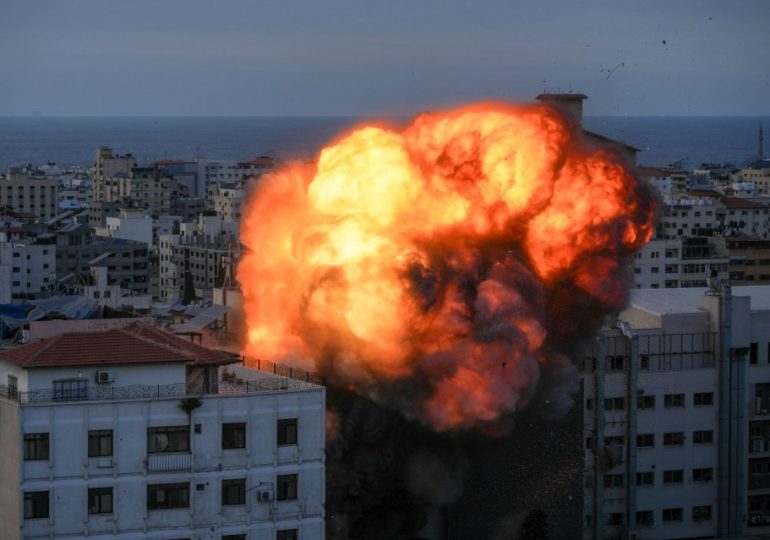MORE than three months on from Hamas’ brutal attacks in Israel and the ensuing Gaza conflict – Western strikes in Yemen threaten to finally spark an all-out war in the Middle East.
Forces led by the UK and US obliterated 60 Houthi targets in total on Thursday under the cover of darkness, weakening the Iran-backed terror proxy in Yemen.
APAn Israeli strike in the Gaza Strip in October 2023[/caption]
RexIDF troops make their way through war-torn ground[/caption]
Thousands of innocent men, women and children have already diedAlamy
It was the first time strikes had been launched against the Houthis following months of brutal Red Sea attacks and regional fighting in the surrounding countries.
The strikes marked a troubling escalation in the crisis that for months has been threatening to ignite an all-out war across the Middle East over Israel’s ongoing battle with Hamas.
And the bold move by Britain and America may just tip the scales.
Since October 7, when Hamas‘ attacks in Israel unleashed war, the Middle East has experienced more turmoil with each new actor to get involved.
In response to Israel’s efforts in destroying Hamas, Iran-backed proxy groups like Hezbollah and the Houthis have pummelled areas in Syria, Iraq, Israel itself and the Red Sea.
Tehran’s funding and wide-reaching influence has proven a deadly background force.
And notorious terror group ISIS appears to be making a terrifying comeback onto the world’s stage as fears of an all-out war grow.
October 7 attacks and Israel-Hamas war
On October 7 the terror group Hamas unleashed horror on Gaza’s border with Israel in a brutal morning ambush.
They unleashed fire at a popular music festival, murdering and kidnapping revellers.
And they stormed several Kibbutz’, Jewish communities, slaughtering families and kidnapping civilians.
Horrifying footage shared by Israeli forces captured the mass murdering of innocents and shocked the world.
Some 1,200 people died during the attacks, and Israel fought back.
Under the watch of Israeli Prime Minister Benjamin Netanyahu, Israel unleashed the full force of its armies, allies and weaponry on the Gaza Strip, vowing to destroy Hamas.
Many thousands of innocent Palestinian civilians – who had been living under a Hamas regime for years – died in the crossfire and continue to be killed.
Hamas militants have also been eliminated, and the IDF continues to pummel the Gaza Strip in hopes of wiping out the murderous group once and for all.
A Jewish woman stands in the remains of a burnt home after the October 7 attacksDan Kitwood/Getty Images
GettyOver 1,200 Israelis were killed[/caption]
Threat of Iran
Iran, a long-standing power player in Middle Eastern conflict, has a large part to play in the current tinderbox dynamic.
Former US ambassador Mark Wallace previously warned The Sun that Tehran is seeking to wreak havoc in the world order with a global campaign of terror.
He also said it has the UK “firmly in its sights”.
“Iran is the number one state sponsor of terrorism and the most egregious, terroristic and destabilising actor on the world stage,” said Wallace, CEO of United Against Nuclear Iran (UANI).
For decades, Iran built up its proxy on Israel’s doorstep from the ground up, starting with its tunnels to smuggle in and hide a seemingly endless supply of rockets and hard cash.
US intelligence estimates that Iran invested a staggering £80million a year in Hamas.
However, the pariah state didn’t stop there.
Together with its terror proxies, it is part self-styled “Axis of Resistance” against Israel, with the explicit aim of destroying the Jewish state at all costs.
And so in increasing amounts since October 7 Iran has unleashed firepower at Israel via its terror proxy groups.
GettyIran’s supreme leader Seyyed Ali Hosseini Khamenei has ruthlessly ruled Iran since 1989[/caption]
GettyIranian protesters burnt an Israeli flag during an anti-Israel rally[/caption]
Army base attacks in Syria and Iraq
America has 2,500 troops permanently stationed in Iraq and 900 in Syria, next door, to prevent and tackle the issue of Islamic State militants.
Beginning in mid-October last year, Iran-backed militia groups – particularly Hezbollah – targeted over 100 US military bases and assets in both countries.
Most attacks involved rockets or drones, targeting the bases by air.
US troops were even reported to be evacuating Syrian bases after becoming the target of militia efforts.
Dozens of soldiers were injured in what the US deemed Iran’s efforts to use its regional proxies in revenge for Israel’s ground operation in Gaza.
White House spokesman John Kirby previously said that Iran was “actively facilitating” the assaults and “spurring on others who may want to exploit the conflict”.
The US went on to launch counterattacks targeting militants involved in the strikes – killing dozens.
America’s presence in the Middle East is a hangover from their years-long occupancy in Iraq and efforts to tackle the Islamic State insurgency – including terrorist group ISIS.
Historically allied forces including the US, UK and other Western countries have fought to tackle ISIS while paramilitary groups – often backed by Iran – fought back.
US troops in Syria
Red Sea attacks
The Houthi rebels of Yemen are a group from a sub-sect of the Shia Muslim minority, the Zaidis.
The group was first formed in the 1990s to combat what they saw as the corruption of then-president, Ali Abdullah Saleh.
In 2003, President Saleh, who was backed by Saudi Arabia’s military, tried to eliminate them.
They failed, and the Houthi have been fighting a civil war against the country’s national government since 2014.
Since the outbreak of the Israel-Gaza war, they sprung from relative obscurity to holding roughly £1trillion of world trade hostage – turning one of the world’s busiest shipping lanes into an active warzone.
The rebel group has been launching relentless drone and missile assaults on any ships they think have links to Israel in solidarity with their ally Hamas.
However, there have been frequent attacks on commercial vessels with little or no link to Israel – forcing global sea traffic to halt operations in the region and sending shipping prices soaring.
On January 12, 2024, explosions rang out across Yemen as the UK and US struck 60 Houthi targets in 16 locations in response to their Red Sea attacks.
Prime Minister Rishi Sunak said they acted in “self-defence” after the Iran-backed militia group vowed America and Britain would “pay a heavy price” for their “blatant aggression”.
Western coalition forces smashed dozens of military targets shortly after the Prime Minister gave the go-ahead at an Emergency Cabinet meeting.
GettyHouthi rebel ambushes a ship in the Red Sea and holds the crew at gunpoint[/caption]
SWNSUK RAF jet heads for Yemen on Thursday to strike back at Houthi strongholds[/caption]
Hezbollah attacks
The Houthi rebels are not the only Iran-backed militia group with violent plans in the Middle East.
Hezbollah is another powerful player, and based in Lebanon which borders northern Israel.
Fears have been swirling for weeks now that the terror group is also planning on joining the conflict.
Allied with Hamas and the Houthis, and backed by Iran, Hezbollah have fired barrages of rockets from Lebanon into Israel consistently since the war began.
It has become one of the most heavily armed, non-state groups in the world thanks to decades of Iranian backing.
One of the largest bombardments came just days ago when 62 rockets were fired into Israel as retaliation for the killing of a Hamas leader.
Key leaders on both sides have died in the attacks, sparking further retaliation.
And Hezbollah leader Hassan Nasrallah issued a chilling warning to Israel in November after the October 7 massacre, fuelling fears of war.
He said “all options are open” and praised the attacks on Israel as a “sacred operation”.
Terror group Hezbollah, allied with the Houthi and Hamas are also backed by Iran
Iran bombing
On January 3 2024, two suicide bombers unleashed an explosive attack in Iran during a memorial parade for infamous Iranian general Qasem Soleimani.
Over 100 people died and around 200 were injured in a horrific double blast.
The bombs went off about 15 minutes apart, striking near the Martyrs Cemetery at the Saheb al-Zaman Mosque.
Civilians had gathered to mark Soleimani’s death in a 2020 US drone strike in Baghdad.
Following the bombing, Iran vowed to “hunt down terrorists” responsible and initially blamed Israel for killing of 103 people.
Iran’s political deputy, Mohammad Jamshidi, blamed the parade attacks on the US and Israel.
But then ISIS said two of their suicide bombers were responsible, reigniting chilling memories about their spate of terror in the region.
X/ @irna_es103 people were killed and hundreds injured[/caption]
ISIS resurgence
Experts have been left fearing a blood-soaked comeback by the notorious terror group amid heightening tensions in the region.
Known for genocide, broadcast beheadings, massacres and terror attacks around the globe – ISIS present a very real threat to global peace.
After establishing themselves in a seat of power across Iraq, they had control over parts of Syria as well and were in fierce fights with countries across the world including the US, Britain and Turkey.
Former US President Barack Obama ordered air strikes against them after the group killed thousands.
And most of the Western world joined forces to exterminate them, taking out some of the group’s mastermind leaders.
By the start of 2018 less than 1,000 ISIS fighters reportedly remained in Iraq and Syria.
And in late 2019, their leader Abu Bakr al-Baghdadi killed himself with a suicide vest during a US raid.
In the years since they have remained quiet and been viewed as a largely neutralised threat.
Aymenn Jawad al-Tamimi, from Middle East Forum, told Reuters that they are now looking to get back to a period of dominance and install fear back into people’s lives.
“The group’s goals remain ever the same: waging jihad against all the group’s enemies in order to establish the territorial Caliphate that should eventually rule the whole world,” he said.
Colonel Richard Kemp spoke to The Sun about why he thinks ISIS claimed responsibility for the horrific bombings.
He said: “I would imagine it’s to rally support for themselves, if they can appear to seem more active than they are at the moment it’s a way of gaining global support and any type of terror success works that way.”
“It may be that they sense the opportunity with conflicts going on elsewhere to jump in themselves.”
AlamyFears are growing that ISIS may be returning[/caption]
X/ @irna_esBlood covers the ground after the double bombing in Iran[/caption]
GettyQasem Soleimani, killed by a US drone strike in 2020[/caption]
AlamyHouthi rebels in Yemen[/caption]
APCivilians in Iran after the bombing in January[/caption]
Leave a comment








